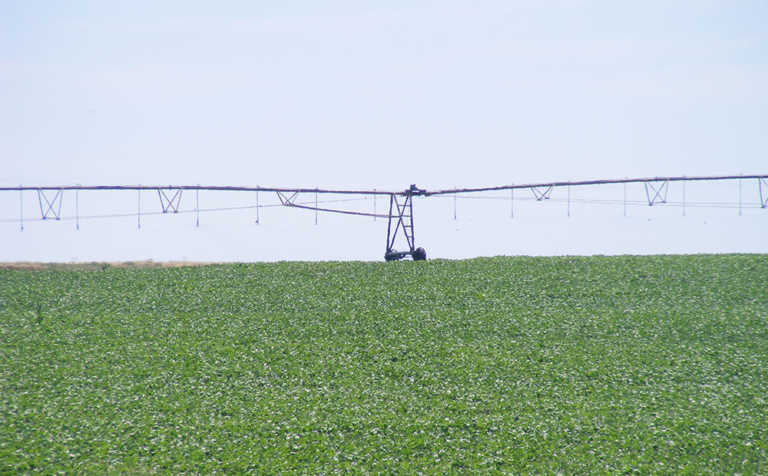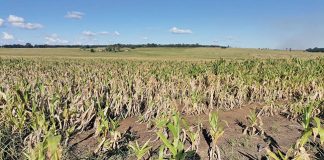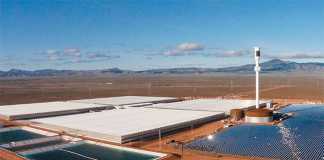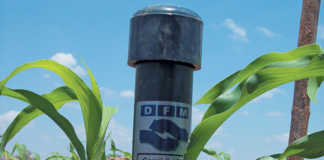
Photo: JL van Vuuren
In a water-scarce country such as South Africa, groundwater resources need to be protected zealously.
Groundwater makes irrigation possible in large parts of the country. However, the efficacy of an irrigation farming concern largely depends on the management of the groundwater supply. Should groundwater levels fall too low or be depleted, farmers will be forced to reduce abstraction from boreholes and downsize irrigation schemes.
With time and significant rainfall such an aquifer may recover to some extent, but it is improbable that it will ever fully recover.
Over-extraction
Geohydrology consultant JL van Vuuren and drilling contractor Marnus Nel, who work mainly in the south-western Free State, have serious concerns about the dangerous decrease in groundwater resources in this region over the past few years.
They ascribe this to poor management practices. Groundwater users, they say, are not aware of the importance of groundwater resource conservation and management, or simply do not appreciate the value thereof. The main reason for the depletion of groundwater is over-abstraction from aquifers.
Although there are no official statistics available for the depletion rates of South Africa’s groundwater, there are many incidences internationally where the misuse of the resource
has had dire consequences.
Marnus says: “On the Atlantic coastal plain of the US for instance, continuous pumping of groundwater has lowered the water table, reduced or eliminated the base flow of streams and caused saline groundwater from the ocean to move inland.”
Groundwater in South Africa is limited due to the geology of the country. Large, porous aquifers occur only in a few areas, such as the southern Free State. JL says aquifers are often the primary source of water in the rural and more arid areas of the country.
Irrigation crop producers, livestock producers, mines and other industries depend largely on groundwater. It is expected that groundwater use for human consumption will further increase, especially in the western part of the country because of a lack of perennial rivers.
According to JL and Marnus, in south-western Free State the scale of irrigation is a problem as irrigation schemes are too large and the volume of groundwater being extracted is
not sustainable.
Another problem is that numerous boreholes are drilled on the same geological structure. This means that these boreholes yield water from the same aquifer.
“It can be likened to a water tank with numerous taps, which results in a rapid decrease of water in the tank. It is important that independent sources of groundwater are targeted and drilled,” says JL.
Long-term cost saving
The most severe consequence of excessive groundwater pumping is that the water table, below which the ground is saturated with water, can be lowered.
For water to be withdrawn from the ground, water must be pumped from a well that reaches below the water table. If groundwater levels decline too far, the well owner might have to deepen the well, drill a new one, or, at least, attempt to lower the pump.
“Also, as water levels decline, the rate at which the well can yield water may decline. As the depth increases, the water must be lifted higher,” JL says.
If a pump is used to elevate water (as opposed to artesian wells), more energy is required to drive the pump. Using such wells for irrigation purposes can become prohibitively
expensive.
In the south-western Free State, it currently costs about R265/m to drill a borehole, while a geohydrological survey costs about R2 500. In the area where JL and Marnus work, groundwater is usually located at between 10m and 50m below the surface.
Most boreholes are about 30m deep, meaning each hole costs about R7 950 for drilling plus R2 500 for the survey.
According to Marnus, new boreholes are often sunk when existing ones dry up. The process of over-abstraction then repeats itself and water shortages will inevitably occur again, at great cost to producers.
Proper borehole installation is a very important aspect of irrigated crop production that is often overlooked.
Although the initial cost is high, the borehole will last for a long time if properly sunk and maintained. JL says the first step before sinking a borehole is to conduct a desktop study
of the designated area.
This includes the study of geological maps and satellite images to indicate the exact positions of geological structures, such as dolerite dykes and sills.
The study must be followed by a magnetic survey; for this a magnetometer is used, which measures the magnetic susceptibility of rocks. Dolerite, for instance, has a high susceptibility. For this reason, it is easily distinguishable from sedimentary rocks such as sandstone and shale.
The data is then downloaded from the magnetometer and interpreted to determine possible drilling locations. Each data point on the magnetometer is associated with a GPS coordinate.
Interpretation will point to a specific coordinate as a suitable drilling point.
In brittle formations and to achieve high-yielding boreholes, it is recommended to case the entire length of the borehole and gravel-pack around the casing.
This ensures borehole stability, allowing easy pump installation and eliminating the danger of a borehole collapsing. Again, this requires a higher initial cost, but in the long run it is the safer and more responsible option.
Only 3% of the rainwater in South Africa reaches the groundwater table to recharge aquifers. To ensure long-term sustainability of groundwater resources, water level measurements need to be regularly taken on existing and newly drilled boreholes.
The hydraulic parameters of an aquifer are established with a pump test, which determines, among other factors, the stress of abstraction. This helps to determine the sustainable yield of a borehole.
This yield is the maximum volume of water that can be abstracted from the borehole to ensure long-term sustainability, JL says.
For a borehole with a high yield it is important that the constant rate pump test continues for between 24 hours and 72 hours. This is necessary to ensure that optimal data sets are available to determine accurate yield.
A step-drawdown test is done prior to the constant rate pump test. This test helps to accurately determine the yield at which the constant rate pump test should be conducted.
A step-drawdown test is a single-well test in which the well is pumped at a low constant-discharge rate until the drawdown within the well stabilises. The pumping rate is 2018increased to a higher constant-discharge rate and the well is pumped until this occurs.
This process is repeated three times, lasting between 30 minutes and two hours each.
A 72-hour test is recommended for irrigation boreholes, costing up to R25 000. A 24-hour test costs about R10 000. While proper pump tests are expensive, they will, in the long run, save you money.
Email JL van Vuuren or Marnus Nel at [email protected].











